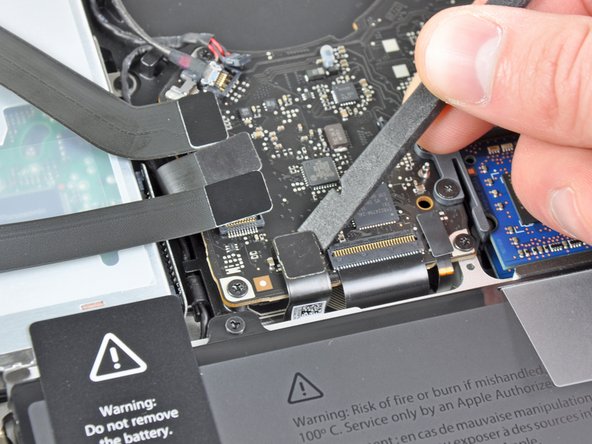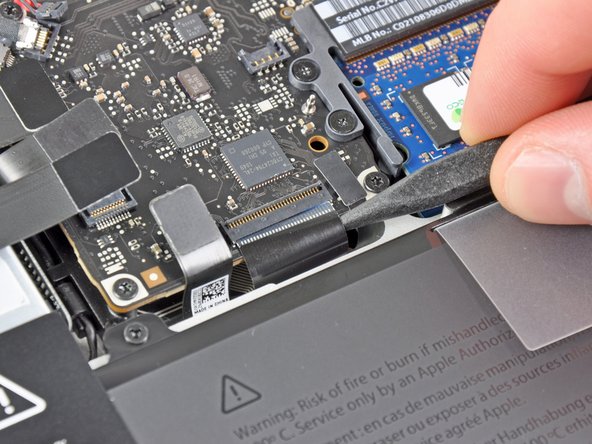MacBook Pro 13″ Unibody Mid 2012 Microphone Replacement
Duration: 45 minutes
Steps: 23 Steps
Hey there! Just a quick heads-up: handle those delicate components with care! If things get tricky, don’t hesitate to reach out for some expert help. You can always schedule a repair if you need a hand!
Ready to tackle that pesky broken microphone? Let’s dive in and get it replaced! With this guide, you’ll be back to chatting and recording in no time. If you need help, you can always schedule a repair.
Step 1
– Let’s get to work! First up, you’ll want to take out those ten screws. You’ve got this!
Step 2
– Time to get those fingers ready! Gently pry the lower case away from the MacBook’s body, focusing on the area near the vent.
– Now, go ahead and lift off that lower case.
Step 3
Gently nudge the connector upwards on both short sides to help it wiggle free from its cozy socket. Just a heads-up: watch out for the corners of those connectors; they can be a bit fragile and might just pop off if you’re not careful.
– Gently nudge the battery connector upwards from its cozy home on the logic board using the edge of a spudger. You’ve got this!
Tools Used
Step 4
– Gently nudge the battery cable away from its cozy spot on the logic board, so it doesn’t decide to reconnect while you’re in the zone. Keep it safe and sound while you work your magic!
Step 5
Check out the second and third pictures to spot the fan socket and the fan connector. As you gently use your spudger to lift the fan connector straight out, keep an eye out for that delicate plastic fan socket on the logic board—let’s not break it! The layout in the second picture might look a bit different from your device, but don’t worry, the fan socket is just the same.
A little twist of the spudger from below those fan cable wires can do wonders to pop that connector loose!
– Gently nudge the fan connector up and out of its cozy socket on the logic board using the edge of a spudger. You’ve got this!
Tools Used
Step 6
– Unscrew the three little buddies that are holding the fan snug against the logic board:
Step 7
– Gently lift the fan out of its cozy spot on the logic board, but keep an eye on that sneaky cable—make sure it doesn’t get snagged!
Step 8
– Grab your trusty spudger and gently coax the right speaker/subwoofer cable out from beneath the little retaining finger that’s holding it snugly in the upper case.
– Now, give that right speaker/subwoofer cable a gentle tug upwards to lift the connector out of its cozy socket on the logic board. You’ve got this!
Tools Used
Step 9
– Gently unplug the camera cable from the logic board. You’ve got this!
Step 10
To unplug those cables, grab the flat end of a spudger and gently lift their connectors out of the logic board sockets. You’ve got this!
– Unplug the following four cables:
Tools Used
Step 11
Just a friendly reminder: make sure you’re lifting the hinged retaining flap, not the socket itself!
– Gently lift up the retaining flap on the keyboard ribbon cable ZIF socket using your fingernail. You’ve got this!
– Grab a spudger and use its tip to carefully pull the keyboard ribbon cable out of its socket. Easy peasy!
– If the cable seems a bit stubborn, no worries! Just stick a little piece of tape on it to help guide it smoothly into the socket. You’re doing great!
Tools Used
Step 12
– If you see it, go ahead and peel off that sneaky little strip of black tape hiding the keyboard backlight cable socket.
Step 13
Make sure you’re lifting the hinged retaining flap, not the socket itself. You’ve got this!
– Gently lift the retaining flap on the keyboard backlight ribbon cable ZIF socket using the tip of a spudger or your trusty fingernail.
– Carefully wiggle the keyboard backlight ribbon cable out of its socket and set it aside.
Tools Used
Step 14
– Gently use the flat end of a spudger to lift the sleep sensor/battery indicator connector out of its cozy little home on the logic board.
Tools Used
Step 15
Be gentle with that display data cable! It’s a bit of a delicate flower. When you need to disconnect it, remember to pull it parallel to the logic board’s face. Treat it kindly, and it’ll thank you later!
– Snag that plastic pull tab attached to the display data cable lock and give it a twist toward the DC-In side of your device.
– Gently pull the display data cable straight out from its cozy spot on the logic board.
Step 16
In certain models, the screws might be a tad shorter, like this:
– Unscrew the nine screws that are waiting for you to take them out!
Step 17
– Let’s kick things off by unscrewing these two little guys:
– Next up, carefully take out the display data cable retainer from the upper case. You’ve got this!
Step 18
– Grab the tip of your trusty spudger and gently nudge the microphone away from the adhesive that’s holding it snugly against the upper case. You’re doing great!
Tools Used
Step 19
– Carefully lift the logic board from the side closest to the optical drive, keeping an eye on those little connectors around the edges.
– Gently wiggle it out of the upper case without bending it, and watch out for that sneaky flexible connection to the DC-In board that might get stuck.
– And voilà, the logic board is out!
Step 20
– Carefully guide the microphone cable out of the channel molded into the left speaker housing. Make sure to take your time and be gentle with it!
Step 21
– Peel off that little piece of black tape that’s hiding the microphone connector. You’ve got this!
Step 22
Gently lift from underneath those wires and watch out for any sneaky connections!
– Gently wiggle the flat end of a spudger to lift the microphone connector out of its cozy spot on the logic board.
Tools Used
Step 23
– Gently pop that microphone off the logic board, and give it a little wave goodbye!





































